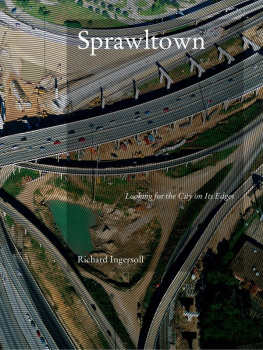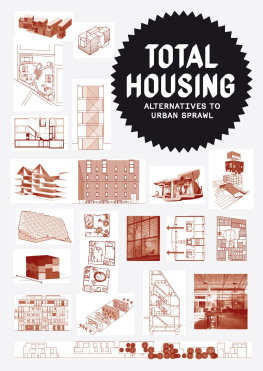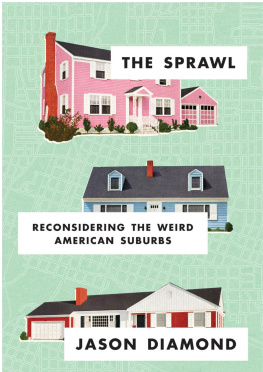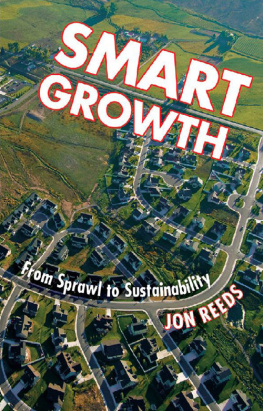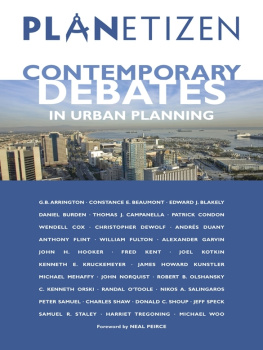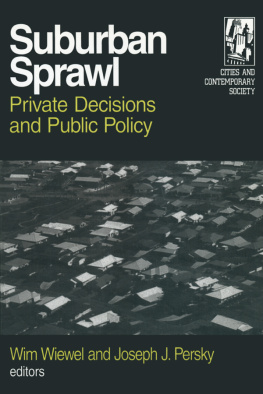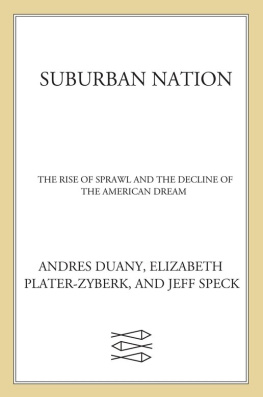Retrofitting Sprawl
EDITED BY EMILY TALEN
Retrofitting Sprawl
Addressing Seventy Years of Failed Urban Form

2015 by the University of Georgia Press
Athens, Georgia 30602
www.ugapress.org
All rights reserved
Designed by Kaelin Chappell Broaddus
Set in 10.4/12.75 Minion Pro Regular by Graphic Composition, Inc.
Printed and bound by Thomson-Shore, Inc.
The paper in this book meets the guidelines for permanence and durability of the Committee on Production Guidelines for Book Longevity of the Council on Library Resources.
Most University of Georgia Press titles are available from popular e-book vendors.
Printed in the United States of America
19 18 17 16 15 P 5 4 3 2 1
Library of Congress Cataloging-in-Publication Data
Retrofitting sprawl : addressing seventy years of failed urban form/edited by Emily Talen.
pages cm
Includes bibliographical references and index.
ISBN 978-0-8203-4544-4 (hardcover : alk. paper) ISBN 978-0-8203-4545-1 (pbk. : alk. paper) ISBN 978-0-8203-4819-3 (ebook) 1. Urban renewalUnited States. 2. Cities and townsUnited StatesGrowth. 3. City planningUnited States. I. Talen, Emily, 1958
HT175.R473 2015
307.34160973dc23
2014042987
British Library Cataloging-in-Publication Data available
Contents
EMILY TALEN
JULIA KOSCHINSKY AND EMILY TALEN
BRENDA CASE SCHEER
GERRIT-JAN KNAAP, AVIVA HOPKINS BROWN, AND REBECCA LEWIS
MATTHEW SALENGER
JUNE WILLIAMSON
DAVID DIXON
ELLEN DUNHAM-JONES AND WESLEY BROWN
NICO LARCO
MARC SCHLOSSBERG AND DAVE AMOS
GABRIEL DAZ MONTEMAYOR AND NABIL KAMEL
BENJAMIN W. STANLEY, AARON GOLUB, MILAGROS ZINGONI, WHITNEY WARMAN, AND CHRISTIAN SOLORIO
GALINA TACHIEVA
Retrofitting Sprawl
INTRODUCTION
Retrofitting Sprawl
EMILY TALEN
This book grew out of a Retrofitting Sprawl symposium held in April 2012 at the Phoenix Urban Research Laboratory (PURL), an urban design center at Arizona State University. We were in the right place for this discussion, as Phoenix ranks high on the list of most sprawling places in the United States. It is, as one observer put it, a thousand-square-mile oasis of ranch homes, back yards, shopping centers, and dispersed employment based on personal mobility. To anyone hoping to reform the way we occupy the land, it is exactly the kind of place in need of retrofitting.
We were all well aware of the enormity of the problem and the intractability of proposed solutions. But, as this book testifies, these hurdles have not stymied creative thinking on the topic in terms of both analysis and proposed remedies. The chapters in this book consolidate multiple perspectives to provide a state-of-the-art overview of current thinking about ways to fixor, as its also called, repair or retrofitsprawl.
We know a lot about sprawl, having spent decades measuring and defining it, quantifying its costs and effects, and unraveling its underlying causes.is in the form of sprawl, it is easy to understand how the terms have come to be used interchangeably.
Since sprawl accompanies urban growth, it has always existed (on this point, there is no disagreement with Sprawl: A Compact History, which painted sprawl as something benign). The problem with sprawl as it currently existsand more specifically, in a twenty-first-century American contextis its magnitude. It became an acute problem following a perfect storm of twentieth-century conditions: the rise of automobiles and expendable income, highway building, housing subsidies, accelerated depreciation, cheap land, Real Estate Investment Trusts (REITS), zoning, subdivision regulations, production builders, and social intolerance. All of these factors and more created the perfect context for the land-consuming, dispiriting landscape we call sprawl.
Sprawl is blamed for some of the most serious problems facing American society: global warming, social inequity, environmental degradation, exorbitant energy use, economic inefficiency and waste, job loss, and the decline of public health. Recently, sprawl has been blamed for exacerbating the deindustrialization of American cities, leading to a decline of not only a once-robust and growing middle class but also an increasingly mythical American dream.
Perhaps these attributions are exaggerated. But the need to do something proactive to address the problem of sprawl resonates widely. In effect, the twenty-first century ushered in its own perfect storm of conditions that necessitated the reverse of sprawl: (1) the need to reduce energy consumption and live local (climate change); (2) the need to build incrementally and in small-scale ways (the global recession); and (3) the need to provide smaller and more centrally located housing types (demographic change). These conditions fundamentally conflict with the scale, pattern, and consumption that accompanies sprawl, mandating a radically different approach to human settlement.
While there is a now a consensus regarding what sprawl is and why its a problem, there is also general agreement about what a world without sprawl would be like: compact, walkable settlements in a variety of forms, including villages, towns, and cities, transit-served and diverse where possible. Rural, low-density settlement is not excluded from this vision, but balance is required. Car dependence that is innocuousthat is, where urban amenities are given up in exchange for access to natureis tolerable. But car dependence that pays no attention to its negative effects is not.
So what can be done about sprawl? Taking to heart that we no longer need to obsess over the question of whether compact, diverse, less car-dependent living is better for the planet, fixing sprawl focuses on what the specific policy and design responses should be. The question before us now is whether government subsidies and funding priorities, market incentives, new kinds of codes, transportation systems, or urban design schemes are achieving or are likely to achieve what is needed.
Retrofitting sprawl will require not only new kinds of tools but also new ways of conceptualizing. Until recently, planners have been mostly focused on sprawl restriction (e.g., growth boundaries), not repairwhich requires a different kind of thinking. A recurrent point is the need for spatial triage: not every place can reinvent itself as a walkable, mixed-use neighborhood surrounded by connecting boulevards. There is a need to prioritize places and tactics, leveraging future investment in ways that stimulate better urbanism in strategic locations.
The idea of fixing sprawl is relatively new, but enough material has accrued to document and learn from efforts so far. Most approaches are novel if not Herculean: failed malls converted to main streets, McMansions transformed into apartment buildings, and big box stores reenvisioned as agricultural land. Ellen Dunham-Jones and June Williamson, with their book Retrofitting Suburbia, were trailblazers in the documentation of retrofitting strategies. Galina Tachievas book Sprawl Repair was similarly path-breaking with its accessible offering of creative design strategies for transforming car-dependent suburbia into something more livable.
The urgency of the issue has resonated with the general public and the popular press: recycling suburbia was recently rated by Time magazine as the #2 Idea Changing the World;
Next page


